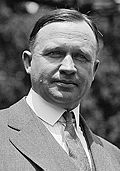November 2, 1920 | |||||||||||||||||
| |||||||||||||||||
 County results Mabey: 40–50% 50–60% 60–70% 70–80% | |||||||||||||||||
| |||||||||||||||||
| Elections in Utah |
|---|
 |
The 1920 Utah gubernatorial election was held on November 2, 1920. Republican nominee Charles R. Mabey defeated Democratic nominee Thomas N. Taylor with 58.17% of the vote.
Contents
This would be the last time a Republican was elected Governor of Utah until 1948.

